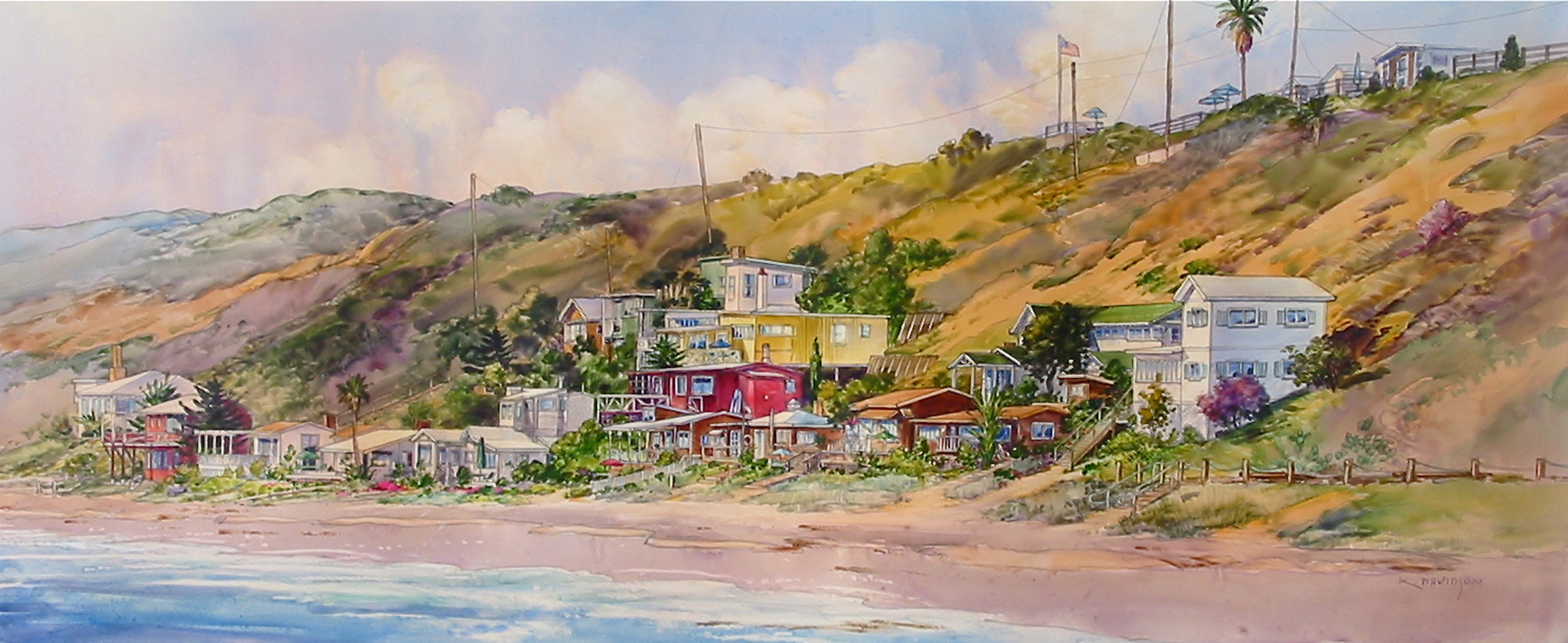Beach Cities Aquatics, Home Aquariums
 Hovering silently, staring straight at me as its fins fluttered delicately against its vivid green and bright pink and yellow body, I wondered just who was watching who through the glass tank wall. The parrotfish soon tired of me (or just was satisfied I wouldn’t make a meal of him) and glided away to bother another brightly colored fish cruising around the tank.
Hovering silently, staring straight at me as its fins fluttered delicately against its vivid green and bright pink and yellow body, I wondered just who was watching who through the glass tank wall. The parrotfish soon tired of me (or just was satisfied I wouldn’t make a meal of him) and glided away to bother another brightly colored fish cruising around the tank.
What is it about watching fish swim around chasing each other, rising to the waterline to pop a drink of air and then turn back down in a kamikaze dive to the bottom, halting instantly to peck at a morsel of sand lining the bottom of the tank as if its slender body had been floating down there all along?
There is no doubt having an aquarium enhances the quality of your life and adding one to your home design would bring peace, harmony, relaxation, and as I see it, a big smile to your face. Just looking at a longhorn cowfish cracks me up (Google it, you’ll laugh too).
And it isn’t that hard to get one started. Really it isn’t. Just hire an expert.
Enter Ryan Powers of Beach Cities Aquatics. He can place an aquarium in a business office, private residence, or even a retirement home. This guy knows all about saltwater life in a tank and how to create the aquarium of your dream. I spoke with Ryan and got the lowdown on what he does and some advice for putting one in your home.
Q: You were the assistant curator at the Tropical Reef Gallery at the Aquarium of the Pacific in Long Beach. Very cool. What was that like?
A: It was an awesome experience. One of the most interesting aspects of my job was getting in the tank with all the sea creatures. Oh my gosh, there were big 250-pound green sea turtles that required vet exams These animals are very powerful and there needed to be four of us divers to handle them, get them in slings and lift them up for the exams. There were also aggressive surgeon (tangs) and triggerfish chasing other fish, and parrotfish clowning around in the tank that made working at the Gallery very amusing.
Q: OK, I have to ask this: I know all animals have their own distinct behaviors and some are perfectly hilarious. Describe the funniest moments you had while at the Tropical Reef Gallery in Long Beach.
A: We have a specific place we call the feeding station where we throw the food to the gathering crowd of gills below us. Our tank houses the porcupine fish which is a funny fish in itself because when it feels the least bit threatened it sucks up water and blows up into a balloon triple its size, more accurately a balloon with sharp spines all over it. Well, this fish learned a way to get our attention so it can be fed first over the other fishes. It filled its mouth full of water, aimed and – bull’s-eye! – spit right on us. You couldn’t help but laugh. We were completely soaked after the feeding frenzy.
Q: How did you get into the aquarium business?
A: In my mid-20s I received a BA in History. But before embarking on my career as an elementary school teacher, I met a friend in the aquarium hobby and helped him set up an aquarium for my first time, and I become hooked.
So I got a job at Laguna Koi Ponds sweeping floors and helping setup ponds. I also started volunteering at the Aquarium of the Pacific in Long Beach and after a year and a half I was hired to take care of the animals. Before too long I was the assistant curator to the largest exhibit, the Tropical Reef Gallery, a 350,000-gallon tank with a variety of fish, sharks, and turtles.
It was a great learning experience to take care of all the animals, the omnivores, carnivores, herbivores. It gave me the chance to become close to them and learn all about their needs, the right vitamins and foods they required.
After eight years I decided to go on my own out in the field setting up aquariums and started Beach Cities Aquatics. In this field there is always something to learn. I love going out putting aquarium’s together. It’s what I do best.
 Q: What does Beach Cities Aquatics provide in the aquarium field?
Q: What does Beach Cities Aquatics provide in the aquarium field?
A: As an experienced aquarium enthusiast, or better known as an aquarist, I can design a beautiful aquarium for your home or business that would include an ecological community, or a biotope, unique to your request. I can create a “snapshot” of most any ecosystem found in the world. I can take a 360-degree acrylic cylinder and arrange it to provide a reef habitat with live corals, marine invertebrates and fish specific to that marine environment.
Aquariums can be built into the wall, be placed in a bedroom or made into a coffee table. Anything can be done with the right design. Currently in Corona del Mar I am working on a half-cylinder reef tank that sits up against a wall and displays a 180-degree view with the filtration piped out into the garage. We also provide pond, saltwater and fountain maintenance and any product needed for the aquarium.
Q: What types of tanks can be put in the homes?
A: There are basically two types of tanks. A Fish Only tank is one that has fish without any sort of corals, anemones or clams. There might be some mobile invertebrates kept for tank cleaning.
The other one is classified as a Reef Aquarium that contains live corals and anemones. This type of system generally contains many varieties of species that require an extremely socialized setup. The needs of the corals or anemones take precedence to the fishes in the tank. Corals are the canaries of the sea and if they are not healthy this indicates the tank is out of balance somewhere.
Q: Is it difficult to maintain? Describe the steps in gearing up a saltwater tank.
A: It really isn’t difficult to maintain a saltwater tank versus freshwater. Saltwater tanks just have a different set of requirements than freshwater ones and are a little less forgiving when it comes to mistakes.
The cycling process where the ecosystem of the tank establishes itself into a rhythm will be the most intense time for setting up and then maintaining your tank. The ammonia, nitrates, and pH have to be monitored. There will be water evaporation to take care of when it occurs. Then as the tank matures, bacteria will start to grow. After the tank completes cycling, a water change is necessary and then regular maintenance should be established.
Q: These days there are so many beautiful aquariums everywhere. Describe what specific equipment is needed to build one in the home.
A: An aquarium is made up of a tank, either glass or acrylic. Acrylic is much lighter and easier to move. You can bend them into a variety of shapes, in fact, into any shape you want. There are cylindrical, square, rectangular, arches, etc., that can be custom designed to fit in your home. Now the benefit to glass is that it doesn’t scratch as easily. If not careful, the acrylic tank can be scratched.
There is the filtration system that consists of a protein skimmer and a sump pump. It’s best to place sumps away from the actual aquarium, such as outside in the garage or backyard. The protein skimmer, another vital piece to keeping the tank healthy, is a small plastic cylinder that is connected to a pump and water is pushed into the cylinder while air is injected and these bubbles separate waste and help take out pollutants.
Warm-water tanks require proper chilling capacity, or warming. A steady temperature reduces stress on the animals, therefore a heat exchanger is needed.
There is also the plumbing to consider for a quiet atmosphere. It is best to plumb 10-15 feet away with overflow boxes to the aquarium.
Q: How do I keep a tank full of fishes happy?
A: Filtration of waste and tank size are important to a successful aquarium. Basically, the smaller the tank the more maintenance is required because of the close environment. A tank no less than 20 gallons should be used, 55 gallons being even better.
That As for happy fishes, you must understand the process water undergoes when it is filled with marine life. Fish create ammonia or what we call waste and then bacteria grows to eat the waste. It takes a certain amount of time for the bacteria to grow, maybe six to eight weeks, until the tank will have its own bacteria cleanup grew breaking down the ammonia.
The biggest mistake is getting too many fish at once, creating too much ammonia buildup in the water. Remember, water quality is the important piece in a healthy fish aquarium. Start out slowly when creating a tank environment to allow the bacteria a chance to establish its presence in the tank. The aquarium needs to be built in steps.
Also, good flow is required for fishes to thrive since a tank needs currents that simulate natural tides in oceans. There is also the salinity, nitrogen and lighting cycle (blue light to bright light phases), and temperature of the water that are basic components to a healthy aquarium. It is all about reducing stress and simulating the environment they came from.
Q: What are the best fish, and/or marine life to use?
A: The best fish are very hardy, such as damsels, triggers, and surgeon, but then again it depends on the species and the personality of that type of fish. Keep in mind, saltwater fish are territorial and will fight each other for their space. Some have sharp dorsal fins or tail fins and butt up to other fishes causing injuries. For instance, triggers are not a good idea in a reef tank because they destroy rock with their sharp teeth and knock down everything with their mischievous antics.
Also,when introducing a similar species into the tank, you might want to have an odd number of fish to keep each other in check. The odd amount of fish keeps them preoccupied, keeps them guessing about each other and preempts aggressive behavior.
Once again, it all depends on the type of fish. We consider the environment and consult with recent research and our own experience in handling marine life and provide the proper ecosystem for the tank.
Q: So I just want my aquarium to lighten up my stressful day and come home, relax and enjoy its beauty. I really don’t want the headaches of maintaining it. Do I have to put any kind of work into my tank or is it all handled by your company?
A: We do it all. We provide all the maintenance backed with 17 years of experience. With reef tanks we usually come out once a week for maintenance.
The only thing you must do is the feeding. It is a major factor in the health of the animal. We do show you the proper way to feed and the variety of foods that are necessary for your aquarium. A word of caution: overfeeding makes for a bad environment, throwing the whole balance of the tank out of whack. Protein bubbles from the excess food makes the water cloudy promoting huge water changes. Automatic feeders you say. Nope, they just dump food all at once and I don’t trust them.
Personally, feeding the fish is not only “zen” inducing, you can control how it is spread around in the tank. And if necessary you can pick out the more timid fish and make sure they get their fair share of the food.
Ryan Powers, Owner
Beach Cities Aquatics
714.616.6905



